12. Apr 2015 - DOI 10.25626/0034
Rasa Baločkaitė is an associate professor of sociology in the Department of Social and Political Theory, Vytautas Magnus University, Lithuania. Her scholarly interests include Soviet and post-Soviet societies, post-colonialism and societies in transitions. Her research has been published in "Problems of Post Communism", "Journal of Baltic Studies", "Slovo", and "Language Policy", among other journals.
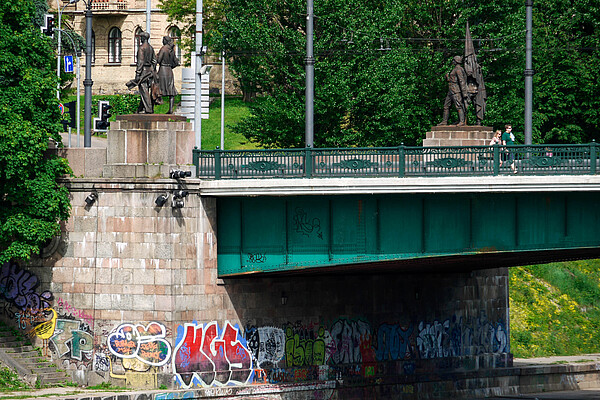
How much Soviet heritage do we need? With opinions ranging from ‘Let’s ban everything produced during the Soviet period’ to ‘Let’s bring Lenin’s statues back into the towns,’ Lithuania has in recent years witnessed heated debates and an extreme polarization of opinions regarding its Soviet heritage. At the epicentre of the debate are four group statues representing major social groups of the Soviet period – industrial workers, peasants, students and soldiers – which were erected on the Green Bridge in Vilnius in 1952. The statues are neither explicitly political nor ideologically neutral, so they survived the fall of the Soviet regime and existed in relative peace until 2010. By then, the material condition of the statues had deteriorated to such a degree that society faced a challenge – to remove or renovate? With the physical collapse of the statues imminent and under pressure to make a quick decision, the case has sparked a culture war in Lithuania, i.e. a radical realignment of opinions into two definable entities, a conflict that has lasted for the past five years without reconciliation.
A culture war is, popularly speaking, a polarization of opinions and a struggle between two sets of conflicting cultural values, typically between those considered traditionalist or conservative and those considered progressive or liberal. The concept of culture war was introduced by American sociologist James Davison Hunter in his 1991 book "Culture Wars: The Struggle to Define America".[1] Hunter described a dramatic realignment and polarization that had transformed American politics and culture, centred around 'hot-button' issues like abortion, gun control, the separation of church and state, privacy, recreational drug use, homosexuality and censorship.
Lithuanian society, like its American counterpart, is strongly divided into two definable entities with regard to specific social issues. Unlike the United States, however, it is also troubled by issues of national identity – language, history, heritage, etc. In recent years, Lithuanian society has witnessed heated debates about the so-called Green Bridge statues, a set of sculptures representing social classes idealized by the Soviet authorities. These are: 'Industry and Construction' (designed by Bronius Vyšniauskas and Napoleonas Petrulis), 'Agriculture' (Petras Vaivada and Bernardas Bučas), 'Youth and Science' (Juozas Mikėnas and Juozas Kėdainis) and 'Guarding Peace' (Bronius Pundzius); they were erected on the Green Bridge in Vilnius's centre in 1952.
The four statues survived both the fall of the Soviet system and a brief public controversy over heritage revisionism in 1990[2], yet after the dismantling of the Soviet bloc in 1992, they were consigned to ambiguity. In 1995, artist Gediminas Urbonas placed mirror cubicles on the heads of the statues[3]; in 2004, artist Vaidas Ramoška decorated the statues by putting red, Christmas-style hats on their heads for four days during the Christmas period[4]; and on 6 May 2007, on the eve of commemorations of the end of the Second World War, the statues were vandalized – a gallows and a star were painted on them in red paint, followed by the inscription 'Russians go home'.[5]
The relative calm around the Green Bridge, interrupted occasionally by random acts of vandalism or artistic experiments, lasted until February 2010, when Moscow's mayor Yuri Luzhkov promised funding for the refurbishment of the Green Bridge memorial in conjunction with the 65th anniversary of the end of the Second World War.[6] The municipality of Vilnius rejected the offer; and then mayor Vilius Navickas, member of the Homeland Union – Lithuanian Christian Democrats, promised to destroy the statues as soon as the Ministry of Culture's Department of Cultural Heritage removed them from the list of state heritage sites. Algimantas Degutis, Deputy Director of the Department of Cultural Heritage, responded: "These objects cannot be expunged from the Register of Cultural Heritage simply upon request. […] The law is the law. […] One cannot act according to political whim – add this, remove that."[7] Soon thereafter the Department of Cultural Heritage sent an official reminder to the City of Vilnius concerning the poor condition and dangerous level of corrosion on the Green Bridge statues and warned them about possible penalties for neglecting the upkeep of state-protected heritage.[8] Some citizen groups observed that the Green Bridge statues feature Soviet symbols (hammer and sickle and the star) and pointed out that the public exhibition, distribution or use of Soviet symbols is forbidden in Lithuania according to the Code of Administrative Offense. However, the Vilnius police department explained that exceptions are applied for objects of cultural heritage. Under the threat of the statues' physical collapse and in light of the legal uncertainty, a new culture war broke out in Lithuania. This war divided Lithuanian society into two definable camps, liberals and traditionalists, who disagreed on the following 'hot-button' issues: How should national history be represented? Are the statues a political or aesthetic phenomenon? How should the Green Bridge statues be framed and how much public exposure do they deserve? Where is the boundary between the 'political' and the 'non-political' with regard to heritage? How do the Green Bridge statues relate to the harm and wrongdoings of the occupying regime? These questions would trouble Lithuanian society for several years to come.
Human memory, both individual and collective, is always selective. History is told by incorporating different episodes into a national narrative, by the active remembrance of desired moments of glory, victories or innocent suffering, and the active forgetting of moments of shame and guilt. The story is never complete and irrevocable; it is always selective, open and fragmented, it is subject to debates and subject to change. In this way, the Green Bridge statues emerged at the epicentre of heated debates among liberals and traditionalists and activated their confronting worldviews.
The liberals advocate for the continuing presence of the Green Bridge issues by arguing for pluralism and diversity in historical representation, the active remembrance of an inconvenient past, and a non-purified version of Lithuanian history. Lina Žigelytė, a doctoral student in Cultural Studies at The University of Rochester in New York, claims that Lithuanian history is too simplified, too romanticized and monumentalized, whereas inconvenient moments of that history tend to remain silenced or underrepresented. She writes: "Cultural memory includes also marginalized narratives that we still tend to avoid, because these narratives are not as uniform and impressive as some romanticized fragments of Lithuanian history."[9] The liberals caution that political hostility and antagonism towards other ideologies are key characteristics of totalitarian states. Violeta Davoliūtė, a cultural historian at Vilnius University, points to current tendencies toward reverse totalitarianism in today's Lithuania: "Attempts to safeguard ideological purity […] bring us back to the much-hated dogma of totalitarianism […] Is not the desire to simplify reality, to eliminate inconvenient aspects from memory, history and community is the modus vivendis of all totalitarian ideologies?"[10] Further, Nida Vasiliauskaitė, a philosopher at Vilnius University, writes: "The city is a space where different ideologies meet and coexist with each other. […] That's why we need signs [of different ideologies]. Otherwise, the one and only ideology, posing as simply order, truth and historical justice, will "clean" the city".[11] Lina Žigelytė similarly argues that "destroying the Green Bridge statues means repeating the Soviet experience – we will find ourselves in a place with no past."[12]
The traditionalists, however, use different arguments and refer to different moral values – they focus on the celebration of national pride, the struggle for freedom, and the possible traumatizing effects of the Green Bridge statues. Journalist Monika Baltrušaitytė argues that ideas of national independence and freedom struggles are central to national narrative and cannot be marginalized: "Do we have any major monuments for our freedom fighters, partisans, members of resistance movement, or genocide victims? […] Yet we maintain the four statues on former Ivan Tcherniakhovski bridge that glorify Soviet socialism during entire independence period."[13] Further, traditionalists argue that Green Bridge statues still function as trauma triggers for those who survived the injustices of the Soviet regime. Kęstutis Masiulis, conservative MP and member of the Homeland Union, calls for greater respect for victims of Soviet oppression: "This constitutes disrespect towards a large part of Lithuanian community who suffered from the Soviet repressions. […] The Soviet ideology meant pain, suffering and deportations for hundreds of thousands of Lithuanians, and now we're using tax payers' money to renovate the symbols of that ideology?"[14] Similarly, the Nationalist Union expresses open condemnation of any renovation-related plans: "We disapprove of the presence of these monsters and we want to express it clearly, that our ethnic feelings are being hurt."[15]
The debates over representing national history and the incorporation of Soviet heritage into that history reveal highly polarized opinions. The liberals use such arguments as diversity of historical representation, non-hegemonic understanding of Lithuanian history, acceptance of the past, and incorporation of dissonant heritage into urban spaces. The traditionalists refer to such values as national independence, greater respect for the partisans and victims of the occupational regime. Both constitute two autonomous moral universes with reference to different moral authorities. Further discussions, instead of leading to consensus, have only revealed disagreement on major aspects of the case.
One of the major disagreements about Green Bridge statues is the question as to whether the statues should be approached as political or aesthetical phenomena. The liberals focus exclusively on the aesthetic function of the statues and downplay the political one. For example, Vasiliauskaitė writes that the Green Bridge statues "are merely workers, peasants, soldiers, and express the specific aesthetics of that time."[16] Gražina Drėmaitė, Chairperson of the State Heritage Commission, asserts that: "Heritage is not politics, […] we cannot make a political decision, we have to do it in civilized way"[17]; whereas the journalist, conservative MP, and former Minister of Foreign Affairs Audronius Ažubalis asks, in response: "If heritage is not political, then what is?"[18] While the liberals focus exclusively on the aesthetic aspects and non-political character of heritage, traditionalists point out its ideological dimensions. Masiulis, a member of Homeland Union, writes: "Of course, I do think about ideological issues. […] the Soviet soldiers, they came here with their guns, occupied our land, inflicted pain on thousands of people we have lost many people; people have died for the sake of freedom. And today, we have here these statues glorifying the Soviet soldiers."[19] Similarly, the political scientist Vladimiras Laučius argues that the statues were "erected for political, not aesthetic reasons. So their lasting legacy should be evaluated on a political, not aesthetic basis."[20]
A further question regarding the Green Bridge issue is that of framing, i.e., how, specifically, should the Soviet statues be framed, both physically and discursively; how and where should they should be displayed; and how should their story be narrated? The Green Bridge statues constitute a particular type of heritage, dissonant heritage. This dissonant heritage is connected to human suffering and political oppression and thus might function as a trauma trigger for survivors or as a favourite gathering spot for adherents of a particular political regime. Typically, a dissonant heritage is subject to varying moral and ethical concerns, and the Green Bridge statues are no exception here. In this case, the liberals recommend the active remembrance and incorporation of this dissonant heritage into the urban space. For example, Žigelytė argues that the presence of Green Bridge statues provides "the possibility of rethinking how to live with our past and write the history, instead of erasing it."[21] The traditionalists suggest reframing the Green Bridge statues and relocating them into museums or other special purpose areas, thus establishing proper distance between the Green Bridge statues and the general public and keeping urban spaces free from possible emotional triggers. On this point Algirdas Patackas, conservative MP and a signer of the Declaration of Independence, writes: "If this kind of object is in a museum, then let it be; but if it is in public space, then it means something else."[22] Similarly, the historian, public activist and Homeland Union member Arvydas Anušauskas writes: "I think they [the statues] belong in a museum."[23]
Finally, there is the question of the fine line between the 'political' and the 'non-political' in discussions of Soviet heritage, a distinction that applies to both material and cultural artefacts, such as monuments, buildings, industrial and living complexes, music, literature, films, etc. Under what criteria should be cultural artefacts be classified as 'political' or 'non-political'? Liberals argue that removing the statues might lead to a 'heritage inquisition', which would include the banning of literature or music produced during the Soviet years. State Heritage Commission chairperson Drėmaitė asks: "Why there are no debates about the novels of Jonas Avyžius? […] Or the music produced by Benjaminas Gorbulskis?"[24] and "If you want search for it [unwanted ideology – RB], you will always find it – the wrong books in the book store, the Soviet music on TV and arts."[25] Traditionalists argue that the presence of the Green Bridge statues will further legitimize the public use of and exposure to Soviet symbols, including statues of Lenin and Soviet slogans. For example, journalist Valentinas Mitė asks: "If these statues have value, maybe we should never have removed those Soviet slogans such as 'Long live the CPSU' or 'The Communist Party is United with our People' and should instead refurbish them carefully year after year?"[26]
Public debates about the Green Bridge statues reveal deep disagreements in all major respects – how political are the statues, how much public exposure do they deserve, and where are the limits of the 'political' when speaking about the Soviet heritage. The Green Bridge statues remain a litmus test, revealing highly polarized public opinions towards the Soviet past in general and Soviet cultural heritage in particular. Why are these opinions so polarized? What is the logic underlying such different and opposing positions?
The different positions towards Green Bridge statues are rooted in different understandings of the harm and violence caused by the Soviet system. Hannah Arendt makes a distinction between the direct violence, i.e. the physical destruction of the opponents of the regime, and the indirect violence of totalitarianism, which "is expressed much more frighteningly in the organization of its followers than in the physical liquidation of its opponents."[27] Both traditionalists and liberals rely on different understanding of the harm and damage done by the Soviet regime.
The liberals focus exclusively on the direct physical violence of the regime, such as deportations, imprisonment, mass killings, etc. For them the Green Bridge statues represent the realm of the 'non political', i.e. regular citizens and their daily lives. Thus, they argue, the statues are ideology-free, politically 'innocent' and suitable for public display. For example, the art critic Laima Kreivytė writes: "We should make a distinction between monuments representing real people, Lenin for example, and abstract ideological representations – the first ones should be removed, and the second ones left as they are."[28] Further, Tadas Bugnevičius argues that the Green Bridge statues "represent not Lenin, Sun Tzu, Chingis Khan, Jesus Christ or Pinocchio, but just regular people – workers, soldiers, peasants and students. It would be hard to discern any ideology there."[29]
The traditionalists, however, focus on the hidden, indirect violence of totalitarianism. For them, the Green Bridge statues represent chief aspects of the hidden, indirect violence of totalitarianism – the totalitarian domination of the state over all spheres of human life, the individual's total dependency on the state, the politicized notion of labour as political mission and moral duty, the total subordination of human life to political ends and ideological purposes, the self denial of personal feelings for the sake of self preservation and the neverending self-censorship in order to comply with political demands. As journalist Baltrušaitytė observes, the Green Bridge statues are not just 'regular people', they are "heroes of the five-year-plan, working-class, proletarian, ideologically lynched intellectuals and armed soldiers of the occupational military forces."[30] Whereas liberals see everyday life as free of ideology, a non-political realm, the traditionalists see everyday life as the primary site for the full-scale operation of indirect violence under totalitarianism. Here, Soviet ideology is represented not by Soviet symbols or objective external artifacts, but by subjective internal artifacts, by the subjects who were forced to internalize that ideology and model themselves according to ideological requirements.
Further, the journalist Audrius Bačiulis comments on a political notion of 'just regular people': “The 'just peasants' had lost their properties and were forced into kolkhoz system, and 'just workers' were literally ' herded' into factories where they have learned cheat, lie and steal, (…) and 'just students' were morally raped on every regular day and forced to deny, in public, the faith and the values of their parents and of their own.”[31] Here, the metaphor of the “moral rape” stands for Arendt’s definition of the hidden, indirect violence of totalitarianism, i.e. people are being forced to accept unwanted and unacceptable, to participate, on permanent basis, in denial of their own moral and ethical principles, to partake in the permanent negation of their own intimate reactions towards injustice and immorality. The “moral rape,” the violation of personal moral and emotional autonomy, results in numbness or, to rephrase Arendt, in man’s radical alienation to the world and to himself, and casts in legacies on future generations.
The two different approaches, liberal and traditionalist, are deeply rooted in different understandings of violence and of the harm done by the Soviet system. Whereas liberals focus on direct physical violence and make a clear distinction between realms of the 'political' and the 'non-political', the traditionalists focus on the indirect violence of totalitarianism and totalitarian domination over all spheres of life. Thus, the first group sees the Green Bridge statues as representing regular citizens in the realm of the 'non-political', whereas the latter sees the subjects represented by Green Bridge statues as ultimate victims of the indirect violence of totalitarianism.
By late 2014, no consensus about the further fate of the Green Bridge statues had been achieved: In August, an online petition for the removal of the Soviet sculptures from the Green Bridge was launched; in early October, a series of protest meetings were held, with demands for the removal of the Green Bridge statues from the Cultural Heritage List; on 31 October, the City of Vilnius issued a new call for tenders for the restoration of the Soviet statues[32]; two weeks later, the Minister of Culture, Šarūnas Birutis, signed a law amending the criteria for cultural artifacts to be listed as heritage. From now on, objects marked with Soviet symbols will not be included in the Register of Cultural Heritage; however, the Department of Cultural Heritage has yet to decide how to protect objects with such insignia that have already been included in the register.[33] The State Cultural Heritage Commission expects to resolve the issue with a conference that, originally planned for fall 2014, has been postponed to spring 2015.[34]
The trouble with the Green Bridge statues is that they are not explicitly ideological, nor ideologically neutral. They stand for what might be called the hidden, indirect violence of totalitarianism. The physical violence inflicted upon the citizens of totalitarian regimes like mass murder, imprisonment, torture, forced labour and relocation has been already critically assessed and openly condemned, and general moral, ethical and legal standards regarding its remembrance are already established. The hidden, indirect violence of totalitarianism, and its effects that are expressed in organization of everyday life, have yet to be assessed. The hidden, indirect violence and its artifacts remain in the grey zone between ideological and aesthetical, between 'political' and 'non political', between trauma triggers and proofs of cultural diversity. Currently, there are no accepted ethical, legal and moral standards and established ways of talking about it, remembering it and dealing with it.
The Green Bridge statues remain a 'hot-button' issue that has divided Lithuanian society into two definable positions. The liberals argue for diversity of historical representation, the refusal to whitewash Lithuanian history, acceptance of the past, incorporation of dissonant heritage into urban spaces, active remembrance, and the aesthetic features of the statues; and they understand totalitarian violence in direct, physical terms. The traditionalists’ arguments are based on values such as national independence, greater respect for the partisans and victims of the occupational regime, the political significance and the possible traumatizing effects of the statues, a trigger-free public space, and the hidden, indirect violence of totalitarianism. The two groups, liberals and traditionalists, constitute autonomous moral universes, subject to different moral authorities, different self-sufficient arguments and different vocabularies. The liberals use words such as diversity, pluralism, acceptance, active remembrance, and non-hegemonic thinking; whereas the traditionalists' final vocabulary is based on concepts such as national independence, freedom struggles, occupation, trauma, victims, propaganda and ideology. These are final vocabularies, to use Richard Rorty's term; they are "'final' in the sense that if doubt is cast on the worth of these words, their user has no noncircular argumentative recourse. Those words are as far as he can go with language; beyond them there is only helpless passivity or a resort to force."[35]
Rasa Baločkaitė: The New Culture Wars in Lithuania: Trouble with Soviet Heritage. In: Cultures of History Forum (12.04.2015), DOI: 10.25626/0034.
Copyright (c) 2015 by Imre Kertész Kolleg, all rights reserved. This work may be copied and redistributed for non-commercial, educational purposes, if permission is granted by the copyright holders. For permission please contact the editors.
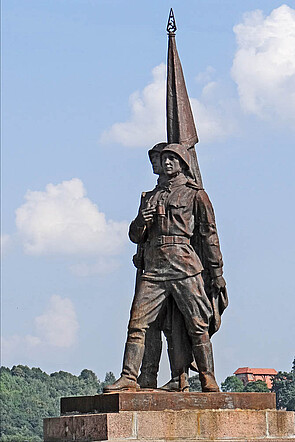
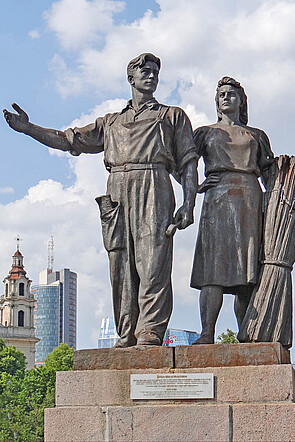
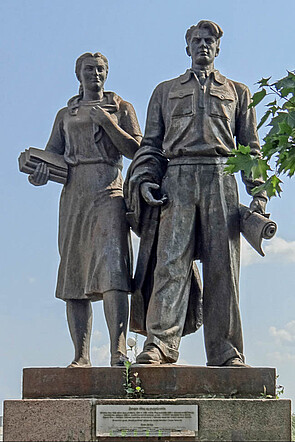
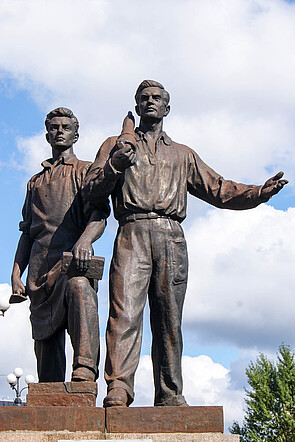
Violeta Davoliūtė · 30.09.2023
Lithuania’s Postcolonial Iconoclasm – or Politics by Other Means
Read more
Violeta Davoliūtė · 29.09.2021
Trials and Tribulations: The Lithuanian Genocide and Resistance Research Centre Reconsidered
Read more
Violeta Davoliūtė · 19.12.2018
Between the Public and the Personal: A New Stage of Holocaust Memory in Lithuania
Read more
Violeta Davoliūtė · 17.11.2017
Heroes, Villains and Matters of State: The Partisan and Popular Memory in Lithuania
Read more
Ekaterina Makhotina · 27.09.2016
We, They and Ours: On the Holocaust Debate in Lithuania
Read more
Get this article as PDF download (including pictures).